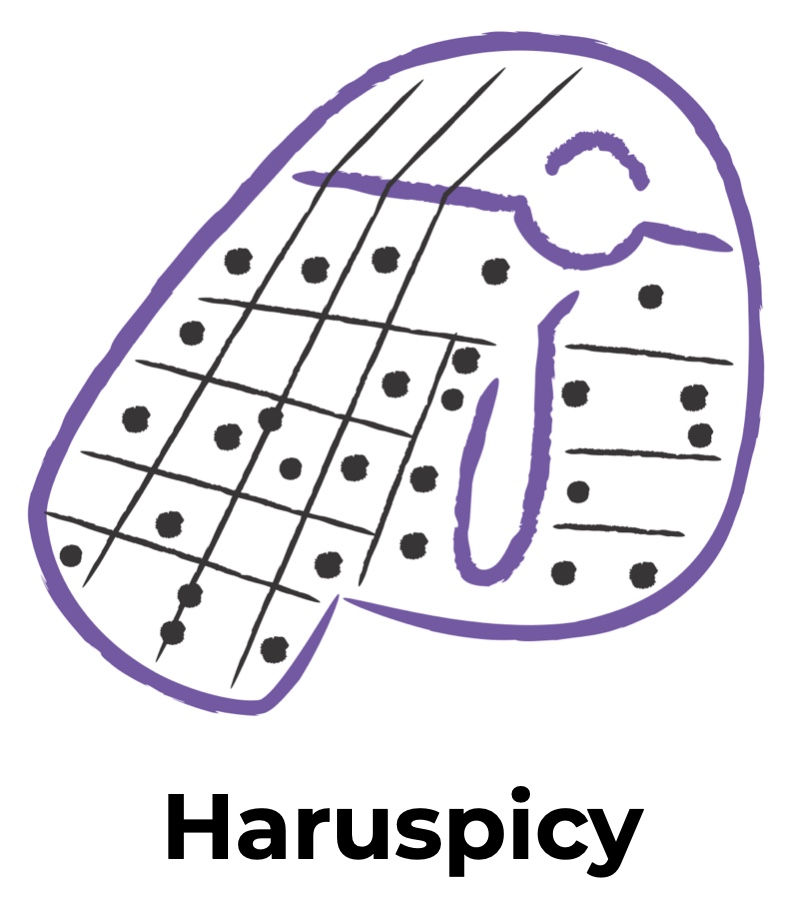Tarot
How to seek a prediction: Anyone can consult an expert (common in almost all European and American cities)
(Sample) Equipment: Tarot Cards!
Personnel: Specialized expert reader of Tarot cards
The Tarot is a card oracle, most often consisting of a deck of 56 "Minor Arcana" and 22 "Major Arcana" or "Trumps." The Minor Arcana have numbered cards and face cards arranged in suits, much like modern playing cards. Major arcana have evocative names like The Fool, Death, and The Wheel of Fortune. Oracular readings are made by drawing one or more cards, often placing them in a particular pattern, and interpreting their symbolic meanings in relationship to the querent. While the Tarot is not the only

card oracle, it is by far the most common, and the term "cartomancy" most often refers to the use of the Tarot for divination.
The cards that evolved into the modern Tarot were originally created as a set of playing cards, much like the simpler decks used in poker and bridge. They were in use from the mid-15th century through the late 18th century, when they began to be used for cartomancy. Early Tarot decks were hand-painted. Some Tarot readers continue this practice today, but most decks are now mass-produced.
Modern Tarot decks come in a variety of styles. Most are similar to the Rider-Waite deck, created and published by A.E. Waite and William Rider in 1910, with illustrations by Pamela Smith. They draw on medieval and Renaissance European symbolism to hide meaning within the illustrations. Other decks incorporate a broad range of influences, ranging from Kabballah to Zen Buddhism to modern internet culture. Differing decks often have different orders for the Major Arcana, different names for the suits (e.g. Coins instead of Pentacles), or even different symbology and interpretations for the same card.
As the demonstration video here shows, a Tarot reading is a personal experience, relying heavily on interpretation by the diviner (reader). Shuffling a Tarot deck is similar to shaking up dice before you roll them, in that it presumably “#randomizes” the outcomes to follow. And, given the seemingly
#deterministic systems prescribed for laying out the randomized cards, it’s important to remind ourselves that interpreting the cards lain out still relies heavily on the conversation between #human querent and diviner, much in the same ways that systems like Ifa and Turkish coffee divination do.
The use of Tarot in divination ceremonies is still common today. Most small cities will have at least one fortune-teller who uses Tarot to advise querents about their day-to-day lives and major decisions. Large cities will have several. Many of these fortune-tellers combine cartomancy with scrying (crystal ball gazing) and other methods.
Tarot Demonstration:
The Tent of Casually Observed Phenologies:
Meet The Expert: Dr. Colin Fredericks
The Diviner's Guide expert on tarot is Dr. Colin Fredericks. Dr. Fredericks is a senior project lead at HarvardX, where he has helped design and produce many HarvardX courses, including PredictionX, Super-Earths and Life, and Energy Within Environmental Constraints. Colin is a man of eclectic hobbies, including tarot and he also designs roleplaying games in his spare time.
Below you can see both a short summary video of Tarot and also a longer, in-depth video; additionally, there is a special segment with artist James Leonard below Colin's video and that video is about James's Tent of Casually Observed Phenologies and how it uses tarot to help connect people to climate change.
Additional Resources:
-
Tarot Cards: The History, Origin, & Uses (from True Ghost Tales)

















